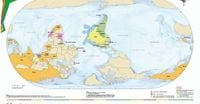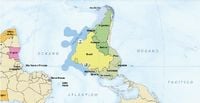On May 8, 2025, the Brazilian Institute of Geography and Statistics (IBGE) unveiled a new world map model that turns traditional cartography on its head—literally. This innovative map features the Southern Hemisphere at the top, positioning Brazil above the United States and Europe. The announcement was made by Marcio Pochmann, the president of IBGE, who stated that the map aims to highlight Brazil's leadership in significant international forums, such as BRICS and Mercosur, as well as its role in hosting COP30 later this year.
"The new map seeks to emphasize Brazil's current leadership position in important international forums like BRICS and Mercosur and in the realization of COP30 in 2025," Pochmann explained. This map not only serves as a geographical representation but also as a symbolic gesture reflecting Brazil's active participation in global discussions, particularly in the context of the Global South.
The map emphasizes countries that are part of blocs with Brazil, including Argentina, Angola, South Africa, China, and Russia. Traditionally, maps have depicted the Northern Hemisphere at the top, a convention established largely by international bodies based in the United States and Europe. However, as the Earth is a sphere, alternative representations are entirely possible. For instance, the United Nations symbol places the North Pole at the center, while maps in China often depict Asia on the left side, closer to the center.
This is not the first time IBGE has experimented with map orientations. In April 2024, they released another map that placed Brazil at the center but adhered to traditional north-up orientation. However, that version faced criticism due to several scientific inaccuracies regarding geological periods, including a significant mix-up between the Jurassic and Cretaceous periods, which misrepresented their ages by millions of years. Following backlash, the institute acknowledged these errors and issued a correction.
Marcio Pochmann, who has been at the helm of IBGE since August 2023, has had a controversial presidency. Appointed by President Luiz Inácio Lula da Silva, Pochmann is known for his heterodox views and has previously led organizations aligned with the Workers' Party (PT), including the Perseu Abramo Foundation and the Lula Institute. His leadership has not been without challenges; internal dissent has emerged, with employees accusing him of authoritarian management practices.
In January 2025, IBGE staff released an open letter criticizing Pochmann's administration, claiming it lacked dialogue with technical staff and was characterized by authoritarianism. They expressed concerns over the establishment of the IBGE+ foundation, which they labeled "IBGE parallel," and protested its creation, leading to its suspension by the government shortly thereafter.
Pochmann has defended his administration, stating that the creation of the IBGE+ foundation was a transparent process that arose from discussions at the 1st National Congress of IBGE Employees held in November 2023. He argued that the foundation was necessary to address budget cuts and rising personnel costs, which he deemed vital for the institution's sustainability.
Despite the controversy surrounding his leadership, Pochmann remains focused on promoting Brazil's international presence. The newly launched upside-down map has sparked mixed reactions online, with many expressing skepticism. However, Pochmann remains optimistic, asserting that this new perspective encourages a reevaluation of Brazil's role in global discussions.
"There is no technical reason for placing cardinal points in conventional directions, and thus, the traditional representation is as correct as the inverted representation," the IBGE stated, emphasizing the validity of their new cartographic approach.
The inverted map is available for purchase on the IBGE website in three sizes, priced at R$ 15, R$ 25, and R$ 90. This initiative aims not only to provide a fresh geographical perspective but also to engage the public in a dialogue about Brazil's position on the world stage.
As Brazil prepares to host COP30 in Belém, the capital of Pará, in November 2025, the timing of this map's release is particularly poignant. It underscores the country's commitment to addressing global challenges, particularly those related to climate change, as it takes on a leadership role in international negotiations.
In the broader context, the idea of presenting maps with unconventional orientations is not entirely new. The concept gained traction in the early to mid-20th century, often motivated by anti-colonial and anti-imperialist sentiments. One notable example is the work of Joaquín Torres García, a Uruguayan artist who famously created the piece "América Invertida" in 1943, advocating for a Latin American identity that values contributions from indigenous peoples.
While the new map has drawn a mix of criticism and support, it undeniably serves as a conversation starter about how geographical representations influence our understanding of global relations. As Brazil continues to navigate its role in international forums, this upside-down map may just be the beginning of a broader rethinking of how we view the world.
Ultimately, the IBGE's new map is more than just a visual representation; it is a statement about Brazil's aspirations and its place in the global order. As the country prepares for significant international events, this innovative approach to cartography may inspire a new narrative about Brazil's leadership and its commitment to fostering collaboration on pressing global issues.


